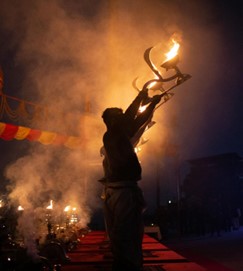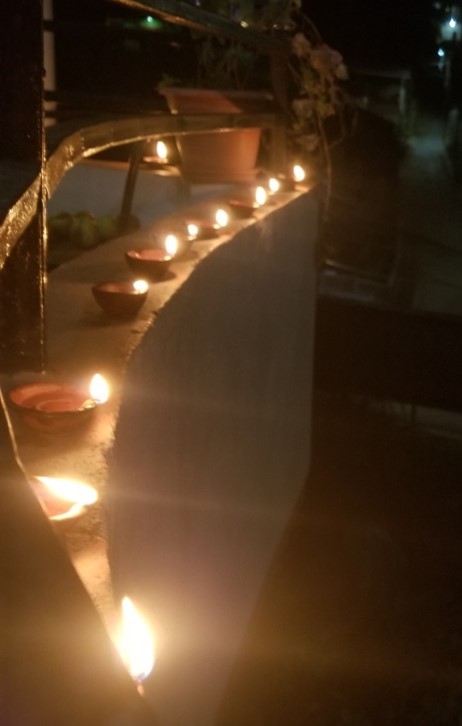Resilient stories from Andaman and Nicobar Srikakulam Community
Author: parminderkaur
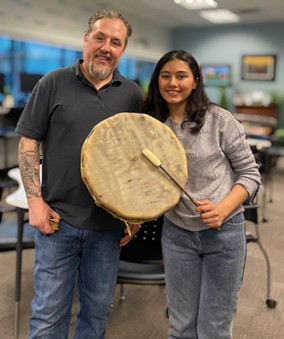
Cultures around the world have always fascinated me, as the cultures that we practice today are a window to the past and the gateway to the future. Having been born and brought up in Nepal, one of the cultural goldmines in the world itself- I have always wondered how my lifestyle, beliefs and practices differ from the rest of the world and how that has shaped me as a person. It has been a dream of mine to travel, explore and experience other cultures and ways of being. Fortunately, I was selected as one of the recipients of the Global Affairs Canada International Scholarships Program and got the opportunity to be here in Kamloops as a visiting research student at Thompson Rivers University. On March 8th, 2024, marking the occasion of International Women’s Day, I was invited to a ‘Hand drum making’ session facilitated by Quanah George, who was introduced as a Tk’emlúps te Secwepemc member and knowledge keeper.
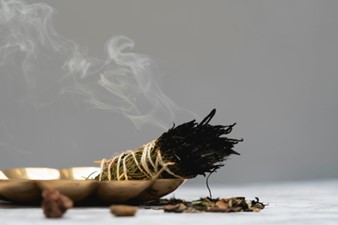
At the beginning of the session, we practiced a smudging ceremony wherein we cleansed our mind, body and spirit. It was a warm reminder of home, especially on the sacred day of Mahashivaratri. Even though I could not physically visit a temple for Mahashivaratri and offer my puja this year, the smudging ceremony allowed me to feel closer to home. The physical gestures of cleansing through the smoke came naturally to me- I had done it innumerable times before for the rituals of my own culture. It led me to an epiphany that irrespective of borders, language barrier, and several other man-made barriers; there is a language in common amongst all humans- the language of art and spirituality.
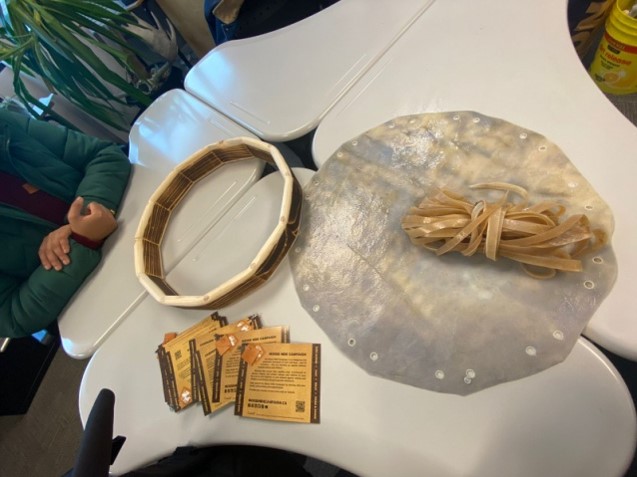
Then we began with the hand drum making steps. We were provided with the materials required to make a hand drum- a wooden hoop, rawhide, and a hide string. All the materials required for crafting a hand drum were neatly arranged on the table. I couldn’t help but feel the weight of their significance. These simple items held within them the stories of centuries marked by colonization- of land, people and culture. Considering that there was a period in history when even assembling the materials for the hand drum would be prohibited or perhaps even criminalized- I realized this session was more than just about making hand-drums. It was about reclaiming and ensuring the preservation of the culture that was so relentlessly sought to be erased.
The rawhide in front of me belonged to a buffalo- as shared by the session facilitator. I was intrigued at how the community utilized so much of the animal with minimal waste. I then reflected on the practices of big-name companies in the meat industry and thought about the sheer amount of waste they produce and the blatant disregard to the ecosystem where profit is concerned; and I felt a deep respect toward indigenous communities who place great value and respect to the life of every sentient being as well as the ecosystem. As we began weaving the hide through the wooden hoop, we were told that the drum holds a sacred value for the indigenous community. The music of the drum is not just for entertainment but it is also used as a spiritual tool- it can help connect people and the divine, heal, and help us be in tune with our spirit. Having seen cultural practices of my own people where music plays such a crucial part in helping people come together, express their emotions, and offer prayers to the divine- I could resonate with the sentiment of music being sacred. All in all, I am beyond grateful to have been a part of this wonderful experience and I would love to learn more about the culture of the Secwepemc community.
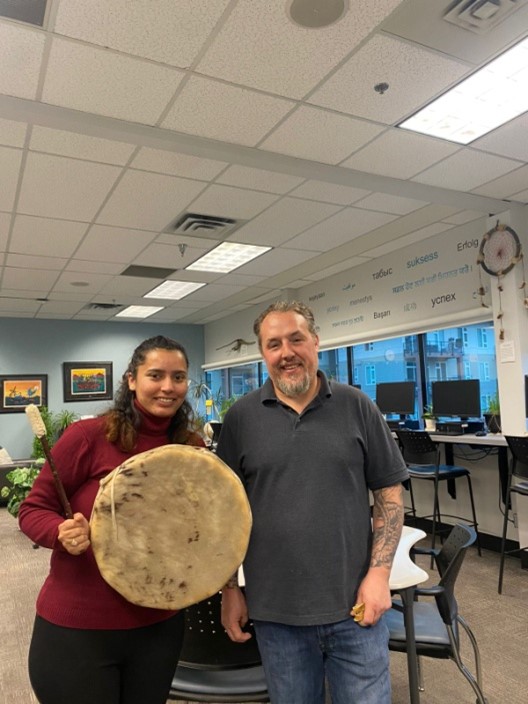

Whenever I travel somewhere, I look for the similarities between the place and my home. It has been more than a week since I arrived in Kamloops. I was selected as a recipient of the Global Affairs Study in Canada scholarship program for 2023/2024. I am now a research student under Dr. Bala Nikku’s supervision at Thompson Rivers University (TRU) because of this I am getting the privilege and opportunity to be engaged in various sessions, workshops, training, and discussions to learn, relearn, and unlearn things.
Recently, I had the honor to participate in the drum-making session at TRU organized by Dian Henderson and facilitated by Quanah George. The session started with a smudging ceremony which is a traditional ceremony performed by Tk`emlúps te Secwepemc member and knowledge keeper to cleanse the soul or aura of negative thoughts of a person or a place. The ceremony started by burning incense made out of herbs. At first, we cleanse our hands as if we were washing our hands but with the smoke then our eyes, mouths, ears, heads, and bodies.
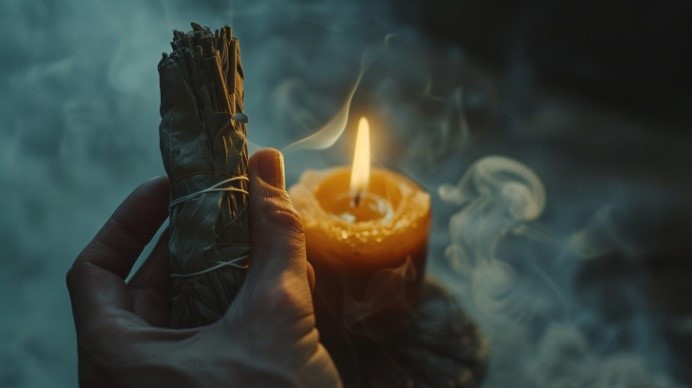
While doing the ceremony it made me realize that the smudging ceremony is similar to doing Aarati in Hindu and Buddhist culture in Nepal. While Aarati can be done by burning the incense (Dhupa) and lamps (Diyo). Dhupa is made out of herbs same as incense for smudging ceremony. Whereas Diyo is made out of clay or metal that holds cotton wick dipped in oil or ghee. Dhupa represents the purification or cleansing of the environment by dispelling negative energies, an offering to ancestors, and a symbol of spirituality and cultural tradition. However, Diyo is offered by lightening the cotton wick by wavering it in a circular motion by reciting certain prayers or mantras. It is a symbol of devotion and gratitude to the divine power. At the end of performing the ceremony of Aarati, we cleanse our hands, face, and head from the Diyo after offering to god as a prasad. This tradition has been an integral part of our rituals and ceremonies for centuries that had been passed down by our ancestors.
Meanwhile, rawhide from deer, elk, buffalo, or steer is used to make a drum that is called Powwow in the native language of Canada. Each group was instructed to follow and by the end of the session, Powwow was ready for each individual. Amongst the Native people, Powwow has its significance as being a part of spiritual healing ceremonies and celebrating indigenous music, art, and food.
The tradition of Powwow has brought the community together by celebrating the various aspects of indigenous spirituality, and identity. It has enhanced the power of strengthening the indigenous group as an individual and as a community.
Likewise In Nepal, Tamang is a large number of indigenous people recognized by the Government of Nepal who use Damphu similar to Powwow as an instrument made up of goat skin. The essence of Damphu is proportionally related to the culture passed down traditionally by the ancestors. It represents the importance of communal gathering that enhances social cohesion, preservation of culture, and spiritual connections. It encompasses the rituals seeking the blessings for prosperity and health of tribal communities accompanied by traditional arts, the transmission of cultural knowledge, and the showcasing of the rich heritage.
Therefore, the similarities between the cultures of indigenous communities in Canada and Nepal have helped to understand the connection between culture, tradition, and spirituality. It shows that despite the differences in origin, geography, and beliefs. Through compare and contrast it signifies that the ideology and philosophy of collectivism can be observed through the similarities between various indigenous communities globally. The philosophy and values of collectivism can be reflected within indigenous groups while engaging with various aspects of life such as community decision-making, educating, and preserving culture. I am fortunate enough to experience and learn the concept of collectivism among the Indigenous community in Canada through this session.

About the author
Namuna is a Generic Social Worker professional from Nepal. She received Canada’s Global Skills Award fellowship and is currently visiting Thompson Rivers University and working with Dr. Bala Nikku at Education and Social Work on a Disaster Resilient Futures Project


